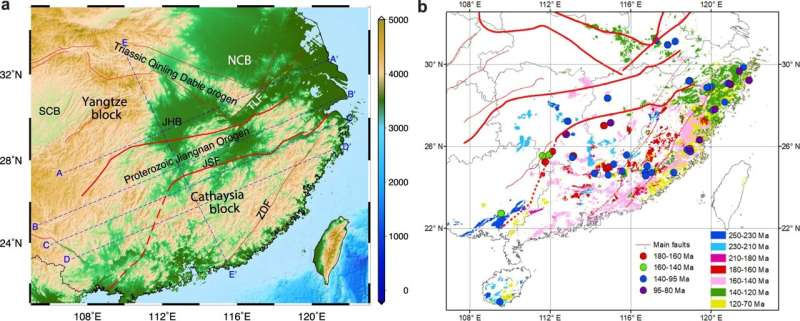This article has been reviewed according to Science X's editorial process and policies. Editors have highlighted the following attributes while ensuring the content's credibility:
fact-checked
peer-reviewed publication
proofread
Seismic waves convey lithospheric delamination mechanism in South China

A research team led by Prof. Zhang Haijiang from the University of Science and Technology of China (USTC) of the Chinese Academy of Sciences, and Prof. Hou Zengqian from Chinese Academy of Geological Sciences, revealed the seismically imaged lithospheric delamination and its controls on the Mesozoic Magmatic Province in South China by using a new joint seismic inversion algorithm. The study was published in Nature Communications.
Based on the latest developed seismic joint inversion algorithm, the researchers made use of the seismic body wave travel time, surface wave dispersion data and receiver function to determine the high-resolution shear wave velocity model of the South China lithosphere. They found that there were high-velocity anomalies in the asthenosphere at a depth of less than 90 kilometers.
These high-velocity anomalies could be interpreted as lithosphere blocks that began to delaminate at 180-170Ma, which was later heated by the deep mantle and floated back to its previous position. Large-scale delamination led to lithosphere transformation, triggering thinning of lithosphere and adiabatic upwelling of asthenosphere. Subsequently, lithosphere extended and overlaying crust melted, forming magmatic province in South China.
As further revealed by geochemical analysis, large amounts of water and heat from the convective mantle was required to trigger delamination. As a result, abundant granitoid and mafic rocks were formed, which explained the formation magmatic rocks and metal deposits.
This study proposed a new understanding of the formation mechanism of Mesozoic magma Province in South China, which help to deeply understand the kinetics of the Paleo-Pacific plate and that of the large-scale mineralization during late Mesozoic in South China. It also provides new ideas for the establishment of the deep process of the lithosphere and the connection between shallow magma and mineralization.
More information: Haijiang Zhang et al, Seismically imaged lithospheric delamination and its controls on the Mesozoic Magmatic Province in South China, Nature Communications (2023). DOI: 10.1038/s41467-023-37855-5
Journal information: Nature Communications
Provided by University of Science and Technology of China





















